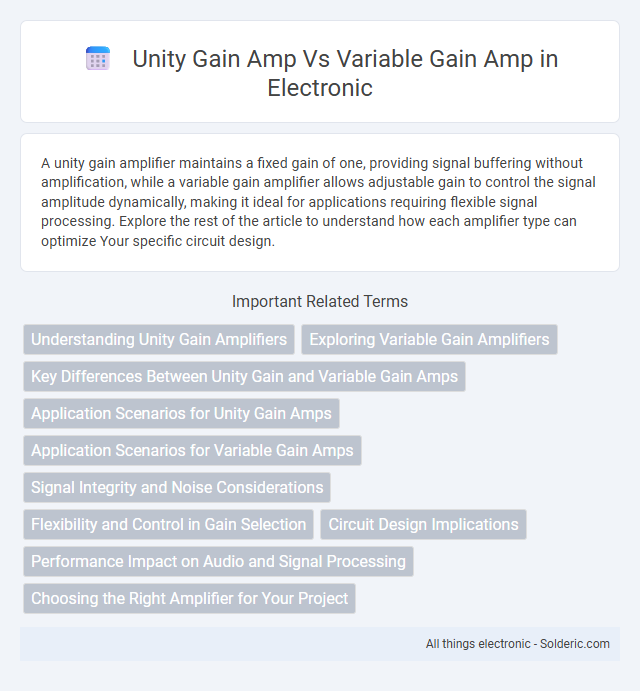A unity gain amplifier maintains a fixed gain of one, providing signal buffering without amplification, while a variable gain amplifier allows adjustable gain to control the signal amplitude dynamically, making it ideal for applications requiring flexible signal processing. Explore the rest of the article to understand how each amplifier type can optimize Your specific circuit design.
Comparison Table
| Feature | Unity Gain Amplifier | Variable Gain Amplifier |
|---|---|---|
| Gain | Fixed at 1 (0 dB) | Adjustable, typically from 0 dB to >60 dB |
| Purpose | Signal buffering, impedance matching | Signal amplification with adjustable output level |
| Complexity | Simple design, low component count | More complex design, requires gain control circuitry |
| Noise Performance | Minimal noise introduction | Dependent on gain setting; higher gain can increase noise |
| Applications | Buffer stages, voltage followers, impedance isolation | Audio volume control, sensor signal conditioning, RF gain control |
| Linearity | High linearity at unity gain | Linearity varies; optimal at specific gain settings |
Understanding Unity Gain Amplifiers
Unity gain amplifiers provide a consistent output identical to the input signal, ensuring signal buffering without amplification or attenuation. These amplifiers maintain a gain of one, which is essential in applications requiring signal integrity and minimal distortion. Your choice between unity gain and variable gain depends on whether constant amplification or adjustable signal control is needed.
Exploring Variable Gain Amplifiers
Variable gain amplifiers (VGAs) provide the advantage of adjustable amplification levels, enabling precise control of signal strength essential for applications like automatic gain control and adaptive filtering. Unlike unity gain amplifiers that maintain a fixed gain of one, VGAs allow dynamic adjustment based on input signal conditions or system requirements, improving performance flexibility. Your signal processing tasks benefit from VGAs by optimizing signal-to-noise ratio and enhancing overall system responsiveness.
Key Differences Between Unity Gain and Variable Gain Amps
Unity gain amplifiers maintain a constant gain of one, ensuring the output signal is an exact replica of the input without amplification, which minimizes distortion and preserves signal integrity. Variable gain amplifiers allow adjustable gain settings, enabling you to control the amplification level for different input signals, enhancing flexibility in applications like audio processing and signal conditioning. The key differences lie in gain adjustability and application suitability, with unity gain amps prioritizing signal buffering and variable gain amps focusing on dynamic amplification control.
Application Scenarios for Unity Gain Amps
Unity gain amplifiers are ideal for buffering sensitive sensor signals in measurement systems where signal integrity and minimal distortion are critical. They are widely used in audio equipment as voltage followers to prevent loading effects without altering the signal amplitude. Applications in data acquisition circuits benefit from unity gain amps by providing high input impedance and preserving the original signal strength for accurate digitization.
Application Scenarios for Variable Gain Amps
Variable gain amplifiers (VGAs) are essential in applications where signal strength varies and precise control over amplification is required, such as automatic gain control (AGC) in communication receivers, audio processing, and instrumentation systems. Unlike unity gain amplifiers, VGAs allow dynamic adjustment of gain to optimize signal-to-noise ratio and prevent distortion across changing input levels. Your system benefits from VGAs when maintaining consistent output amplitude in environments with fluctuating signals or when implementing adaptive filtering techniques.
Signal Integrity and Noise Considerations
Unity gain amplifiers maintain consistent signal amplitude, minimizing distortion and preserving signal integrity by preventing gain-related noise amplification. Variable gain amplifiers adjust signal amplitude but can introduce increased noise and distortion as the gain changes, affecting overall signal quality. Careful design and component selection are crucial in variable gain amps to optimize signal integrity and minimize noise across varying gain levels.
Flexibility and Control in Gain Selection
Variable gain amplifiers provide enhanced flexibility and precise control over the amplification level, allowing users to adjust gain dynamically to suit varying signal conditions. Unity gain amplifiers offer a fixed gain of one, preserving signal integrity without amplification or attenuation, but lack adaptability. This inherent control in variable gain amps makes them ideal for applications requiring real-time gain adjustments and optimized signal processing.
Circuit Design Implications
Unity gain amplifiers simplify circuit design by maintaining a constant gain of one, which minimizes distortion and noise, making them ideal for buffering and signal isolation tasks. Variable gain amplifiers require more complex feedback and control circuitry to adjust gain dynamically, increasing design complexity and power consumption but offering flexibility for applications needing signal level adaptation. Your choice between them impacts the overall circuit stability, power efficiency, and signal integrity depending on the specific application requirements.
Performance Impact on Audio and Signal Processing
Unity gain amplifiers maintain a constant amplification factor of one, preserving the original audio signal's integrity without introducing distortion or noise, making them ideal for buffering and impedance matching in audio applications. Variable gain amplifiers offer adjustable gain, enabling dynamic control over signal amplitude, which is essential for applications requiring volume variation, automatic gain control, or signal conditioning but may introduce nonlinearities that affect audio fidelity. The choice between unity and variable gain amps directly impacts signal-to-noise ratio, harmonic distortion levels, and overall audio clarity in signal processing systems.
Choosing the Right Amplifier for Your Project
Choosing the right amplifier for your project depends on whether you need consistent output or adjustable signal strength. Unity gain amplifiers provide a fixed gain of one, ideal for buffering and impedance matching without altering signal amplitude. Variable gain amplifiers allow you to control the output level dynamically, making them suitable for applications requiring signal scaling or automatic gain control.
unity gain amp vs variable gain amp Infographic

 solderic.com
solderic.com